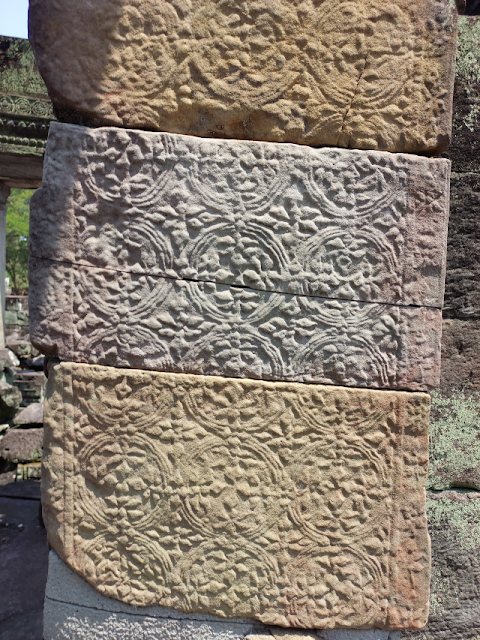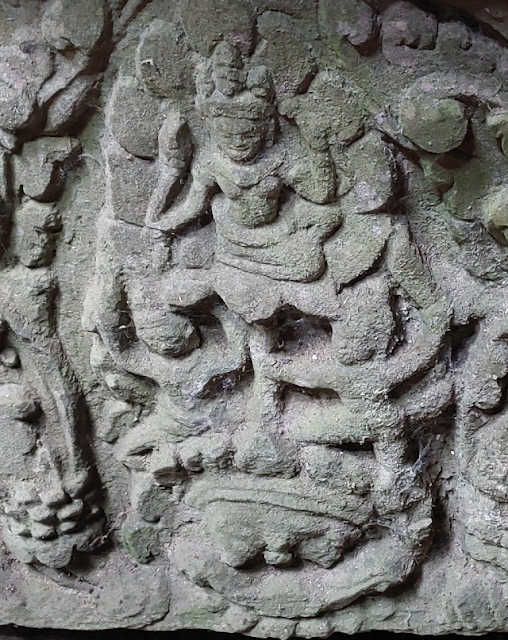Hall of Dancers is located to the east of 2nd enclosure, in between east Gopuram 3 and the main temple entrance. One cannot miss not seeing the beautiful dancers on lintles everywhere.
Hall of dancers:
The eastern gopura leads to the Hall of Dancers.
the structure has small courtyards
Now roofless, Hall of Dancers has dancing Apsara lintels everywhere. It has 102 pillars.
The hall measures 26 meters by 36 meters. There are four small courtyards with dancing apsaras on lintels.
central sanctuary at the back of Hall of Dancers in the picture above
walls and panels decorated with dancing apsaras
One fascinating feature about these dancers is that the expression of each is different. Were they modeled on real girls or was it the imagination of the sculptor?
dancing Apsara on a pillar
pillar with motif
floral door jambnaga on floor
praying ascetic
Before entering the Hall of Dancers, on the north side on the wall is a relief with Buddha figures. Water seepage seems to have done a lot of damage. It was impossible getting a more clearer picture
view of central sanctuary from Hall of Dancers
Well preserved reliefs on the ground.
The above relief shows a scene from Vessantara Jataka. Prince Vessantara pouring water on the hands of Jujaka, giving his two children to him. Two children can be seen in the center below Vessantara and Jujaka.
This lintel on the ground of central passage shows Price Vessantara pouring water on the Jujaka and handing his two children to him.
Towards south, is a lintel with Buddhist female personification of wisdom, Prajnaparamita.
the above relief shows Garuda on the northern (left) side and Buddha sitting on lotus on southern(right) side, in the center is an ascetic sitting cross legged with folded hands.
Just before exiting, on a lintel is an image of Buddha with multiple arms.
The algae and fungal growth have made the image unnoticeable.
Buddha with multiple arms
Libraries:
In between the Hall of Dancers and the entrance of temple (Gopuram 2) on either side are two small structures. These are the two libraries of Preah Khan.
entrance to enclosure 2
beautiful dancing Apsaras on gopuram

inside view of tree dismantling the wall
North and South libraries
Most of the libraries face east but here, they face west towards the main temple. Their purpose probably was only to keep holy scriptures inside.
North library
lintel shows praying asceticsSouthern satellite temples:
The southern side of temple is not a very good shape. One can walk through the vestibule but, most part of this section of temple is unaccessible.
dwarpala on enclosure 2
here also each holds a staff
On the floor, lies a broken lintel, Buddha surrounded by moss
Another relief on floor
The relief shows Vishnu sitting on lotus with mace in one hand and a lotus in another.
southern side of temple
Western Satellite temples:
The western part of the temple was dedicated to Vishnu. One can see some very beautiful and well preserved pediments on temples in west and south eastern satellite temples. Scenes such as Krishna lifting Mount Govardhana, dancing Shiva.
northern part of temple
southern side
inside southern side of temple
southern side of temple, another view
Inner view of south entrance gate, false balustered windows towards inner side of the temple
south entrance gate
the pediment shows a standing figure supposedly Vishnu with multiple arms
lintel shows Krishna lifting Mount Govardhana
on way to central sanctuary, a relief lies on the side
Yoni pedestal, straight ahead is the central sanctuary
Shiva Linga in North temple in 2nd enclosure from west direction
Northern satellite temples:
Most carvings in northern satellite temple depict scenes from Bhagwata Purana or Ramayana. One can see some very beautiful and well preserved pediments on temples in west and south eastern satellite temples. Scenes as Krishna lifting Mount Govardhana, dancing Shiva.
This side of the temple is mainly dedicated to Shiva. But temples dedicated to Vishnu can also be seen.
Krishna lifting the mountain of Govardhan
Indra, the god of rain got very angry at Krishna and in his wrath, showered so much rain that the place got flooded. Krishna lifted the mountain of Govardhan on his pinky finger and everyone including the animals took refuge under it.
Krishna lifting the mountain, next to him is Balram, his brother. The pediment clearly illustrates people sitting along with animals.
On the extreme left is visible the reclining Vishnu pediment in the eastern courtyard of northern temple
pediment is not clear but lintel shows Garuda
Garuda on lintel
the pediment is not clear but the lintel shows Shiva
dancing Shiva
Lord Shiva in meditation
Shiva placing his foot on Apasmara
Shiva stepping on Apasmara
Apasmara(अपस्मार) represents spiritual ignorance. To maintain and preserve the knowledge in the world, Shiva decided to subdue Apasmara and not kill it. This way the balance between ignorance and spiritual knowledge could be maintained.
In the above pediment, Shiva is seen with multiple arms, frayed hair and has his foot on Apasmara so as to subdue it.
a foot on Shivlinga
Eastern courtyard of northern temple:
On the eastern courtyard of northern temple is one of the most beautiful carving of reclining Vishnu. I was so fascinated by the carving that I kept on taking pictures in deep admiration.
One of the most beautiful pediments is Vishnu reclining on Ananta short corridor with carvings on wall as well
In the pediment, Anantshayana( reclining on Ananta) Vishnu is seen on door pediment. Ananatshayana meaning reclining on Ananta. Lakshmi, his consort is seen near his feet. Lotus represent Brahma. According to Vishnu Purana, lotus are said to come out from the navel of Vishnu signifying Brahma.
The "sheshanaga", who is a serpent on which he reclines is somewhat different, it looks more like a mix of lion and dragon with legs. The scales on body are clearly visible.
Since, Vishnu reclines on naga in ocean, marine life is so well depicted with fish, tortoise at the base of lintel.
Worshippers sit with folded hands.
Something like this is seen in Banteay Samre.
Vishnu in Banteay Samre
Opposite to Vishnu gate, is another gate with Shiva on pediment.
The pediment shows Shiva in deep meditation in Mount Kailash which is his abode. The mountain is depicted by small zig zags over his head. Worshippers can be seen seated around and below him.
Reliefs on floor:
Some very well preserved reliefs can be seen on the floor of eastern gopuram of second enclosure.
This lintel on the ground of central passage shows Price Vessantara pouring water on the Jujaka and handing his two children to him. Two small children can be seen below the hands.
Towards south, is a lintel with Buddhist female personification of wisdom, Prajnaparamita.
The above relief shows a scene from Vessantara Jataka. Prince Vessantara pouring water on the hands of Jujaka, giving his two children to him. Two children can be seen in the center below Vessantara and Jujaka.
This lintel on the ground of central passage shows Price Vessantara pouring water on the Jujaka and handing his two children to him.
In this lintel, on the left stands Garuda on either on a lotus or an elephant, in the center an ascetic sits on top of makar and on the right sits Buddha on a lotus.
Different buildings:
Two structures between north and east direction are quite different from the rest of construction.
Two-storey building:
To the north of Hall of Dancers or just walk on the muddy path on enclosure 2 north temple building, turn right and you see two storey building standing on circular columns.
The architecture of this building is very different and somehow does not seem to fall into place with other structures. Seems to be influenced by Greek architecture, especially the columns.
the upper part of the structure is not there but a line of praying ascetics can be seen.
The purpose of this structure is not clear. It is speculated that it once housed the "Sacred Sword" (Preah Khan) after which the temple has been named.
decorated upper floor
decorated pillar
The pillars are decorated with beautiful motifs
view of sanctum sanctorumOn side of this structure, are depressed areas, guarded by naga railings. Maybe, after being filled with water, they served as reflection pools.
There is a pond and short steps with lions on side lead to northern temple and another to a two-storied structure. Maybe, it was a place for taking a bath before entering these places. Such ponds are present on all corners of temples according to the map.
pond in near ceremonial platform
lion by the pond
Ceremonial platform:
West to the two-storied structure is a raised platform with lions as guards.
What type of ceremonies used to take place can only be speculaed. Was it a venue for cremations or for royal assembly?
Lion guard stairs are both sides
I enter the first enclosure which was very confusing and taking notes was a daunting task.


































































































No comments:
Post a Comment
Thanks for visiting my blog. Your feedback is always appreciated.